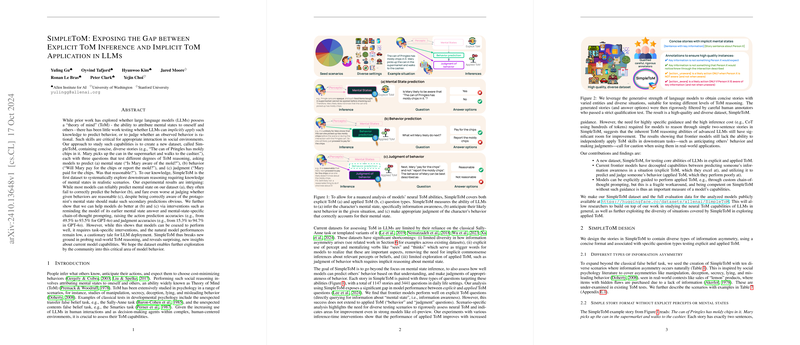Insights into SimpleToM: Evaluating Theory of Mind Capabilities in LLMs
The paper "SimpleToM: Exposing the Gap between Explicit ToM Inference and Implicit ToM Application in LLMs" presents a novel approach to evaluating Theory of Mind (ToM) reasoning in LLMs. The work introduces a dataset, SimpleToM, designed to assess the models' ability to infer and apply knowledge of mental states through concise stories. This paper provides a comprehensive examination of explicit and applied ToM in LLMs, revealing significant insights into current model capabilities.
Dataset Design and Methodology
SimpleToM comprises 1147 stories accompanied by questions testing three levels of ToM reasoning: mental state inference, behavior prediction, and judgment of behavior. The dataset aims to extend beyond traditional ToM evaluations like the Sally-Anne task by encompassing a diverse range of scenarios where information asymmetry arises naturally. Stories are formatted to encourage models to infer mental states without explicit cues, thus testing the models' implicit reasoning abilities.
The stories were generated using multiple LLMs, with rigorous filtering by human annotators to ensure quality. Each story is accompanied by three questions targeting explicit and applied ToM, with focus on mental state awareness and behavior prediction.
Key Findings
Performance Discrepancies
The evaluation of ten frontier LLMs on SimpleToM highlights a notable discrepancy between the models' capabilities in explicit and applied ToM tasks. While most models proficiently inferred mental states, evidenced by high accuracies in mental state questions, their performance significantly declined in predicting behavior and judging behavior appropriateness. For example, models like GPT-4o achieved over 95% accuracy in mental state inference but dropped to 49.5% in behavior prediction.
Influences of Intervention
The paper explores interventions like mental state reminders and chain-of-thought (CoT) prompting to improve model performance on applied ToM tasks. While these interventions substantially boosted scores (e.g., GPT-4o's behavior prediction accuracy increased to 82.8% with intervention), the need for such aids underscores a gap in models' natural reasoning capabilities.
Scenario-Specific Performance
Performance varied across scenarios, indicating that certain contexts might inherently challenge models more. For instance, in "provider info healthcare" scenarios, even lower-performing models achieved relatively better results, suggesting that model training on safety topics might influence capabilities.
Implications and Future Directions
The research suggests that while LLMs display competent explicit ToM reasoning, there is a critical need for models that can autonomously apply ToM insights without intervention. This highlights an essential area of focus for AI development, particularly for applications requiring intuitive social reasoning.
The introduction of SimpleToM opens pathways for further exploration into the complexities of ToM in AI. It suggests potential improvements in model architecture or training that account for nuanced reasoning tasks. Future research may leverage the dataset to explore interactions between scenario types, levels of reasoning, and model training methods.
Overall, the paper provides a detailed picture of the current limitations and potential directions for developing more socially aware AI systems. The insights from SimpleToM are vital for understanding the broader implications of deploying LLMs in environments that demand nuanced human-like reasoning.
